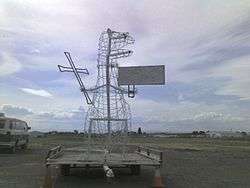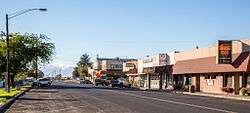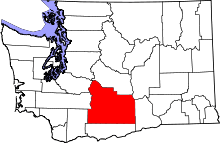Zillah, Washington
| Zillah | |
|---|---|
| City | |
| Zillah, Washington | |
|
First Avenue | |
 Location of Zillah in Washington | |
 Zillah Location in the United States | |
| Coordinates: 46°24′13″N 120°15′39″W / 46.40361°N 120.26083°WCoordinates: 46°24′13″N 120°15′39″W / 46.40361°N 120.26083°W[1] | |
| Country | United States |
| State | Washington |
| County | Yakima |
| Area[2] | |
| • Total | 1.78 sq mi (4.61 km2) |
| • Land | 1.78 sq mi (4.61 km2) |
| • Water | 0 sq mi (0 km2) |
| Elevation | 820 ft (250 m) |
| Population (2010)[3] | |
| • Total | 2,964 |
| • Estimate (2015)[4] | 3,138 |
| • Density | 1,665.2/sq mi (642.9/km2) |
| Time zone | PST (UTC-8) |
| • Summer (DST) | PDT (UTC-7) |
| ZIP code | 98953 |
| Area code(s) | 509 |
| FIPS code | 53-80500[5] |
| GNIS feature ID | 1512822[6] |
| Website | City of Zillah |
Zillah is a city in Yakima County, Washington, United States, with a population of 2,964 as of 2010 census. Tourist attractions include the Teapot Dome Service Station, the fortuitously named Church of God Zillah and the local wineries.
History
Zillah was founded in 1891 following the completion of the Sunnyside Canal project, an irrigation scheme delivering water from the Yakima River to the arid lower Yakima Valley. Walter Granger, superintendent of the canal company, chose the town site in 1892. The town was named for Miss Zillah Oakes, daughter of Thomas Fletcher Oakes, who as president of the Northern Pacific Railway had backed the building of the canal. The town was named after Miss Zillah because she would scream and cry on the way to the new town, while on the trip her father promised to name the town after her if she would stop. Granger housed the headquarters of the Washington Irrigation Company in Zillah, giving it economical advantages for a time. He also made his residency in Zillah becoming its mayor after retiring from the irrigation company. Zillah was officially incorporated on January 5, 1911.[7]
Geography
Zillah is located on Interstate 82 about 15 miles (24 km) southeast of Yakima.
According to the United States Census Bureau, the city has a total area of 1.78 square miles (4.61 km2), all of it land.[2]
Demographics
| Historical population | |||
|---|---|---|---|
| Census | Pop. | %± | |
| 1920 | 647 | — | |
| 1930 | 728 | 12.5% | |
| 1940 | 803 | 10.3% | |
| 1950 | 911 | 13.4% | |
| 1960 | 1,059 | 16.2% | |
| 1970 | 1,138 | 7.5% | |
| 1980 | 1,599 | 40.5% | |
| 1990 | 1,911 | 19.5% | |
| 2000 | 2,198 | 15.0% | |
| 2010 | 2,964 | 34.8% | |
| Est. 2015 | 3,138 | [8] | 5.9% |
| U.S. Decennial Census[9] 2015 Estimate[4] | |||
2010 census
As of the census[3] of 2010, there were 2,964 people, 1,033 households, and 741 families residing in the city. The population density was 1,665.2 inhabitants per square mile (642.9/km2). There were 1,105 housing units at an average density of 620.8 per square mile (239.7/km2). The racial makeup of the city was 63.8% White, 0.3% African American, 3.8% Native American, 0.9% Asian, 0.2% Pacific Islander, 27.1% from other races, and 3.9% from two or more races. Hispanic or Latino of any race were 42.5% of the population.
There were 1,033 households of which 43.4% had children under the age of 18 living with them, 53.0% were married couples living together, 13.1% had a female householder with no husband present, 5.6% had a male householder with no wife present, and 28.3% were non-families. 23.9% of all households were made up of individuals and 8.9% had someone living alone who was 65 years of age or older. The average household size was 2.87 and the average family size was 3.40.
The median age in the city was 31.9 years. 31.4% of residents were under the age of 18; 8.9% were between the ages of 18 and 24; 27.3% were from 25 to 44; 22.9% were from 45 to 64; and 9.3% were 65 years of age or older. The gender makeup of the city was 49.8% male and 50.2% female.
2000 census
As of the census[5] of 2000, there were 2,198 people, 792 households, and 591 families residing in the city. The population density was 1,807.9 inhabitants per square mile (695.6/km²). There were 837 housing units at an average density of 688.4 per square mile (264.9/km²). The racial makeup of the city was 73.25% White, 0.82% African American, 2.14% Native American, 0.77% Asian, 0.36% Pacific Islander, 18.29% from other races, and 4.37% from two or more races. Hispanic or Latino of any race were 26.07% of the population.
There were 792 households out of which 40.2% had children under the age of 18 living with them, 56.9% were married couples living together, 13.8% had a female householder with no husband present, and 25.3% were non-families. 21.7% of all households were made up of individuals and 10.0% had someone living alone who was 65 years of age or older. The average household size was 2.78 and the average family size was 3.22.
In the city the population was spread out with 31.2% under the age of 18, 8.2% from 18 to 24, 27.6% from 25 to 44, 19.3% from 45 to 64, and 13.7% who were 65 and up. The median age was 33 years. For every 100 females there were 92.0 males. For every 100 females age 18 and over, there were 89.0 males.
The median income for a household in the city was $38,214, and the median income for a family was $44,688. Males had a median income of $33,819 versus $23,603 for females. The per capita income for the city was $16,415. 13.8% of the population and 9.0% of families were below the poverty line. Out of the total population, 16.4% of those under the age of 18 and 16.6% of those 65 and older were living below the poverty line.
Schools
The Zillah School District is a small rural district of approximately 1250 students, housed in four buildings. Zillah is one of the smallest districts in area in Yakima County (estimated 44 square miles).
Schools Include:
- Hilton Elementary School houses grades K-3.
- Zillah Intermediate School , the newest of the schools, holds grades 4–6.
- Zillah Middle School is for grades 7–8.
- Zillah High School (Home of the Leopards)
- Zillah also has an alternative school program .
Tourist attractions

- Church of God Zillah – Although the church is fairly conservative and some are unamused by this coincidence (the church was named long before the Godzilla movies began), the church embraces it, even putting a wireframe Godzilla float outside. The church officially calls itself "Christian Worship Center".[10]
- Teapot Dome Service Station – National Historic Site.
- Several world class wineries
Other churches
- Zillah Church of the Nazarene Sunday Worship 10:45 am
Zillah Church of the Nazarene celebrated their 75th Anniversary in the community in 2007. - Faith Community Church
- Church of Jesus Christ of LDS
- Zillah First Baptist Church
- Grace Lutheran Church
- Valley Covenant Community Church
- Catholic Church Resurrection
- Christian Worship Center
References
- ↑ "US Gazetteer files: 2010, 2000, and 1990". United States Census Bureau. February 12, 2011. Retrieved 2011-04-23.
- 1 2 "US Gazetteer files 2010". United States Census Bureau. Archived from the original on January 24, 2012. Retrieved 2012-12-19.
- 1 2 "American FactFinder". United States Census Bureau. Retrieved 2012-12-19.
- 1 2 "Population Estimates". United States Census Bureau. Retrieved June 29, 2016.
- 1 2 "American FactFinder". United States Census Bureau. Archived from the original on September 11, 2013. Retrieved 2008-01-31.
- ↑ "US Board on Geographic Names". United States Geological Survey. October 25, 2007. Retrieved 2008-01-31.
- ↑ History Archived May 9, 2008, at the Wayback Machine.
- ↑ "Annual Estimates of the Resident Population for Incorporated Places: April 1, 2010 to July 1, 2015". Retrieved July 2, 2016.
- ↑ United States Census Bureau. "Census of Population and Housing". Archived from the original on May 11, 2015. Retrieved August 31, 2014.
- ↑ Stephanie Earls. Church of God-Zillah. The Seattle Times. June 10, 2000. Accessed November 7, 2009.

